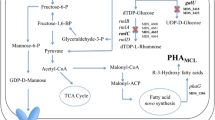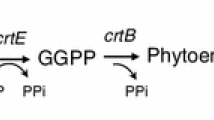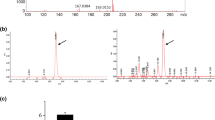Abstract
NADPH-dependent reactions play important roles in production of industrially valuable compounds. In this study, we used phosphofructokinase (PFK)-deficient strains to direct fructose-6-phosphate to be oxidized through the pentose phosphate pathway (PPP) to increase NADPH generation. pfkA or pfkB single deletion and double-deletion strains were tested for their ability to produce lycopene. Since lycopene biosynthesis requires many NADPH, levels of lycopene were compared in a set of isogenic strains, with the pfkA single deletion strain showing the highest lycopene yield. Using another NADPH-requiring process, a one-step reduction reaction of 2-chloroacrylate to 2-chloropropionic acid by 2-haloacrylate reductase, the pfkA pfkB double-deletion strain showed the highest yield of 2-chloropropionic acid product. The combined effect of glucose-6-phosphate dehydrogenase overexpression or lactate dehydrogenase deletion with PFK deficiency on NADPH bioavailability was also studied. The results indicated that the flux distribution of fructose-6-phosphate between glycolysis and the pentose phosphate pathway determines the amount of NAPDH available for reductive biosynthesis.





Similar content being viewed by others
References
Alper H, Jin YS, Moxley JF, Stephanopoulos G (2005a) Identifying gene targets for the metabolic engineering of lycopene biosynthesis in Escherichia coli. Metab Eng 7(3):155–164. doi:10.1016/j.ymben.2004.12.003
Alper H, Miyaoku K, Stephanopoulos G (2005b) Construction of lycopene-overproducing E. coli strains by combining systematic and combinatorial gene knockout targets. Nat Biotechnol 23(5):612–616. doi:10.1038/nbt1083
Bartek T, Blombach B, Zonnchen E, Makus P, Lang S, Eikmanns BJ, Oldiges M (2010) Importance of NADPH supply for improved L-valine formation in Corynebacterium glutamicum. Biotechnol Prog 26(2):361–371. doi:10.1002/btpr.345
Chemler JA, Fowler ZL, McHugh KP, Koffas MA (2010) Improving NADPH availability for natural product biosynthesis in Escherichia coli by metabolic engineering. Metab Eng 12(2):96–104. doi:10.1016/j.ymben.2009.07.003
Chin JW, Cirino PC (2011) Improved NADPH supply for xylitol production by engineered Escherichia coli with glycolytic mutations. Biotechnol Prog 27(2):333–341. doi:10.1002/btpr.559
Chin JW, Khankal R, Monroe CA, Maranas CD, Cirino PC (2009) Analysis of NADPH supply during xylitol production by engineered Escherichia coli. Biotechnol Bioeng 102(1):209–220. doi:10.1002/bit.22060
Cunningham FX, Jr., Sun Z, Chamovitz D, Hirschberg J, Gantt E (1994) Molecular structure and enzymatic function of lycopene cyclase from the cyanobacterium Synechococcus sp strain PCC7942. Plant Cell 6(8):1107–1121. doi:10.1105/tpc.6.8.1107
Farmer WR, Liao JC (2001) Precursor balancing for metabolic engineering of lycopene production in Escherichia coli. Biotechnol Prog 17(1):57–61. doi:10.1021/bp000137t
Kim S, Lee CH, Nam SW, Kim P (2011a) Alteration of reducing powers in an isogenic phosphoglucose isomerase (pgi)-disrupted Escherichia coli expressing NAD(P)-dependent malic enzymes and NADP-dependent glyceraldehyde 3-phosphate dehydrogenase. Lett Appl Microbiol 52(5):433–440. doi:10.1111/j.1472-765X.2011.03013.x
Kim YM, Cho HS, Jung GY, Park JM (2011b) Engineering the pentose phosphate pathway to improve hydrogen yield in recombinant Escherichia coli. Biotechnol Bioeng 108(12):2941–2946. doi:10.1002/bit.23259
Kurata A, Kurihara T, Kamachi H, Esaki N (2005) 2-Haloacrylate reductase, a novel enzyme of the medium chain dehydrogenase/reductase superfamily that catalyzes the reduction of a carbon-carbon double bond of unsaturated organohalogen compounds. J Biol Chem 280(21):20286–20291. doi:10.1074/jbc.M414605200
Kurata A, Fujita M, Mowafy AM, Kamachi H, Kurihara T, Esaki N (2008) Production of (S)-2-chloropropionate by asymmetric reduction of 2-chloroacrylate with 2-haloacrylate reductase coupled with glucose dehydrogenase. J Biosci Bioeng 105(4):429–431. doi:10.1263/jbb.105.429
Lee WH, Park JB, Park K, Kim MD, Seo JH (2007) Enhanced production of epsilon-caprolactone by overexpression of NADPH-regenerating glucose 6-phosphate dehydrogenase in recombinant Escherichia coli harboring cyclohexanone monooxygenase gene. Appl Microbiol Biotechnol 76(2):329–338. doi:10.1007/s00253-007-1016-7
Lovingshimer MR, Siegele D, Reinhart GD (2006) Construction of an inducible, pfkA and pfkB deficient strain of Escherichia coli for the expression and purification of phosphofructokinase from bacterial sources. Protein Expr Purif 46(2):475–482. doi:10.1016/j.pep.2005.09.015
Martinez I, Zhu J, Lin H, Bennett GN, San KY (2008) Replacing Escherichia coli NAD-dependent glyceraldehyde 3-phosphate dehydrogenase (GAPDH) with a NADP-dependent enzyme from Clostridium acetobutylicum facilitates NADPH dependent pathways. Metab Eng 10(6):352–359. doi:10.1016/j.ymben.2008.09.001
Phillips GJ, Park SK, Huber D (2000) High copy number plasmids compatible with commonly used cloning vectors. Biotechniques 28(3):400–402, 404, 406 passim
Sanchez AM, Andrews J, Hussein I, Bennett GN, San KY (2006) Effect of overexpression of a soluble pyridine nucleotide transhydrogenase (UdhA) on the production of poly(3-hydroxybutyrate) in Escherichia coli. Biotechnol Prog 22(2):420–425. doi:10.1021/bp050375u
Siedler S, Bringer S, Bott M (2011) Increased NADPH availability in Escherichia coli: improvement of the product per glucose ratio in reductive whole-cell biotransformation. Appl Microbiol Biotechnol 92(5):929–937. doi:10.1007/s00253-011-3374-4
Siedler S, Bringer S, Blank LM, Bott M (2012) Engineering yield and rate of reductive biotransformation in Escherichia coli by partial cyclization of the pentose phosphate pathway and PTS-independent glucose transport. Appl Microbiol Biotechnol 93(4):1459–1467. doi:10.1007/s00253-011-3626-3
Vinopal RT, Clifton D, Fraenkel DG (1975) PfkA locus of Escherichia coli. J Bacteriol 122(3):1162–1171
Wakao S, Benning C (2005) Genome-wide analysis of glucose-6-phosphate dehydrogenases in Arabidopsis. Plant J 41(2):243–256. doi:10.1111/j.1365-313X.2004.02293.x
Walton AZ, Stewart JD (2004) Understanding and improving NADPH-dependent reactions by nongrowing Escherichia coli cells. Biotechnol Prog 20(2):403–411. doi:10.1021/bp030044m
Yoon KW, Doo EH, Kim SW, Park JB (2008) In situ recovery of lycopene during biosynthesis with recombinant Escherichia coli. J Biotechnol 135(3):291–294. doi:10.1016/j.jbiotec.2008.04.001
Acknowledgement
This work was supported in part by National Science Foundation CBET0828516. Y. Wang was partially supported by a postdoctoral fellowship from the HHMI Beyond Traditional Borders program and by a John S. Dunn Foundation Collaborative Research Award. The authors want to thank Prof. Kurata for providing plasmid pET101-D-topo-CAA43 and Prof. Benning for the gift of pASK-IBA3-G6PD1.
Author information
Authors and Affiliations
Corresponding author
Rights and permissions
About this article
Cite this article
Wang, Y., San, KY. & Bennett, G.N. Improvement of NADPH bioavailability in Escherichia coli through the use of phosphofructokinase deficient strains. Appl Microbiol Biotechnol 97, 6883–6893 (2013). https://doi.org/10.1007/s00253-013-4859-0
Received:
Revised:
Accepted:
Published:
Issue Date:
DOI: https://doi.org/10.1007/s00253-013-4859-0




